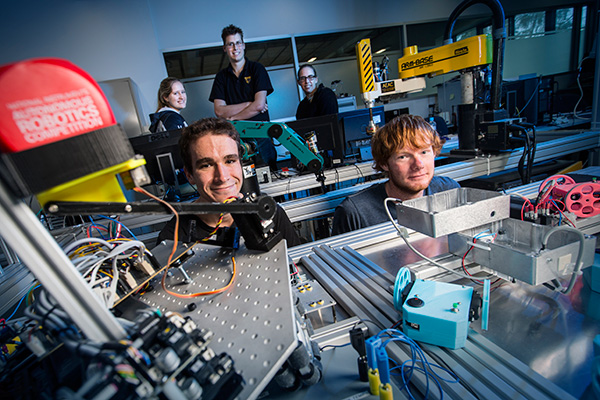September 12, 2014
Robots sowing the seeds for advanced agriculture
Engineering students are developing the future of farming through an automated seed-planting robot.

Team UOW Robotics members (L to R) Andrew Short, Cameron Hickling, Alison Haire, Scott Dudok and Sophie Counsell.
A team of engineering students are testing their design skills in a national competition to build a self-driven robot that can navigate a field and plant seeds for crops.
Team UOW Robotics is a student-led project with support from the Faculty of Engineering and Information Sciences that will face off against teams from top universities across Australia and New Zealand in the annual National Instruments Autonomous Robotics Competition (NI ARC).
The theme for the 2014 competition is 'Go, Sow, Grow!' It is based on solutions for agriculture, an important industry across Oceania and a key growth industry for robotics and automated machinery.
Each team is required to build and program a self-driven robot that can pick up blocks representing seeds, deposit the blocks in designated planting areas while navigating a course littered with obstacles. To complete the task the robot then has to navigate back to the home zone.
Team UOW Robotics has been refining their robot for the past five months ahead of the 25 September final at Macquarie University.
Team member and mechatronic engineering student Andrew Short said they had been taking advantage of new technology including 3D printing to build and refine the robot.
“We even have robots building robots,” he said. “One of our in-house pieces of fabrication equipment was used to build the base of the competition robot.”
In addition to designing and building a robot according to strict competition guidelines, the team must program the software that will ultimately lead to success or robot that crashes into every obstacle in its path.
“The robot navigates by a light-detection sensor to locate objects and fix its position,” Andrew said. “We have to write the algorithm that takes the sensor data and helps the robot navigate.
““It seems like a simple proposition when you first read the competition brief but when you start to build a robot that can drive itself and can figure out its position relative to other objects its suddenly not that easy.”
Similar sensing technology is used in vehicles in underground mines and other places where there is no satellite navigation signal.
Team mentor and mechatronic engineering research fellow Nathan Larkin said the project provided invaluable practical experience for the team’s undergraduate students.
“The students will see a design problem during the build process and they’ll recognise it as something they have learned earlier in their degree and now they have the opportunity to apply what they’ve learned with the added pressure of the meeting competition rules and deadlines.”